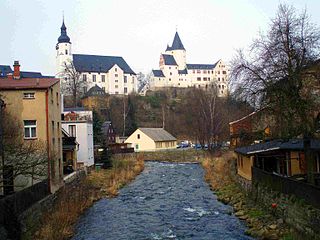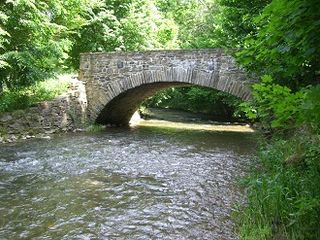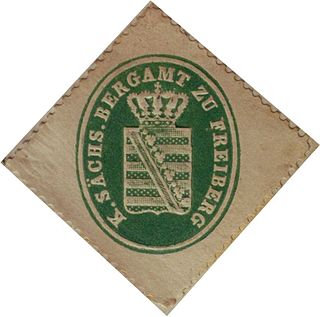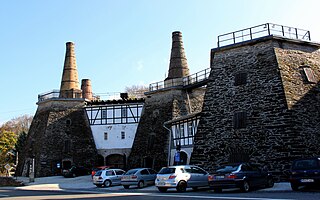Related Research Articles

Ullmannite is a nickel antimony sulfide mineral with formula: NiSbS. Considerable substitution occurs with cobalt and iron in the nickel site along with bismuth and arsenic in the antimony site. A solid solution series exists with the high cobalt willyamite.

Aue is a small town in Germany at the outlet of the river Schwarzwasser into the river Zwickauer Mulde in the Ore Mountains, and has roughly 16,000 inhabitants. It was merged into the new town Aue-Bad Schlema in January 2019. Aue was the administrative seat of the former district of Aue-Schwarzenberg in Saxony, and is part of the Erzgebirgskreis since August 2008. It belongs to the Silberberg Town League

Kauern is a German municipality in the Thuringian Landkreis of Greiz. It belongs to the Verwaltungsgemeinschaft of Wünschendorf/Elster.

Schneeberg is a town in Saxony’s district of Erzgebirgskreis. It has roughly 16,400 inhabitants and belongs to the Town League of Silberberg. It lies 4 km west of Aue, and 17 kilometres (11 mi) southeast of Zwickau.

Bad Schlema is a community in the district of Erzgebirgskreis in Saxony in Germany. It was merged into the new town Aue-Bad Schlema in January 2019. It belongs to the Silberberg Town League. The Silver Road (Silberstraße) runs through the town. The community is developing its tourist industry, above all its spa facilities.

SAG/SDAG Wismut was a uranium mining company in East Germany during the time of the cold war. It produced a total of 230,400 tonnes of uranium between 1947 and 1990 and made East Germany the fourth largest producer of uranium ore in the world at the time. It was the largest single producer of uranium ore in the entire sphere of control of the USSR. In 1991 after German reunification it was transformed into the Wismut GmbH company, owned by the Federal Republic of Germany, which is now responsible for the restoration and environmental cleanup of the former mining and milling areas. The head office of SDAG Wismut / Wismut GmbH is in Chemnitz-Siegmar.
Berggeschrey or Berggeschrei was a German term for the rapid spread of news on the discovery of rich ore deposits that led to the rapid establishment of a mining region, as in the silver rush in the early days of silver ore mining in the Ore Mountains. It is similar in some respects to the gold rush in North America.

The Schwarzwasser is a right tributary of the Zwickauer Mulde in the German state of Saxony and the Czech Republic. It flows through Schwarzenberg.

The Döhlen Basin is a landscape unit in the German federal state of Saxony, southwest of Dresden. The Döhlen Basin has a length of 22 km and a width of 6 km and lies within the district of Sächsische Schweiz-Osterzgebirge.

The Eichelbach is a river of Hesse, Germany. It is a tributary of the Nidda, 18 kilometres (11 mi) long.

The Bobritzsch is a river of Saxony, Germany. It is a right tributary of the Freiberger Mulde with a length of about 38 km (24 mi). Its Gewässerkennzahl is 5422.

The Pließnitz is a river of Saxony, Germany. It is a right tributary of the Lusatian Neisse, which it joins near Görlitz.

This is a list of erratics on and around Rügen – the largest island off the Baltic coast of Germany. An erratic is usually defined as an individual block of rock lying on the surface of the land which has a volume of at least one cubic metre and which was transported by a glacier to its present site during the ice age.

The Saxon Mining Office is the executive authority for mining rights in the German state of Saxony. It is also responsible for all non-metallic mineral resources on the terrain of the former East Germany.

The Eula is a tributary of the River Wyhra in northwestern Saxony in Germany. It has a length of 31 kilometres (19 mi) and a catchment area of about 171 km2 (66 sq mi).

The Lengefeld Lime Works is a limestone mine southwest of Lengefeld in the Saxon town of Pockau-Lengefeld in the Ore Mountains. It is the last mine in Saxony and the last mine on the German side of the Ore Mountains that still transports men and materials into the mine up and down vertical shafts.
Manfred Bochmann was an East German politician who served as his country's Minister for Geology for fifteen years.

The Finstergrund Pit near Wieden in the Black Forest in Germany is an abandoned medieval silver and lead mine that was also used in the modern era to extract fluorite and baryte. Since 1982 it has been used as a visitor mine.

In Austrian politics, the Federal Ministry of Agriculture, Regions and Tourism is the ministry in charge of agricultural policy, forestry, hunting, fishing, viticulture and wine law, postal and telecommunications services, mining, animal welfare, and the tourism industry. The Ministry was first created in 2000 through a merger of the Ministry of Agriculture (Landwirtschaftsministerium) and the Ministry of Environment (Umweltministerium); it gained responsibility for the energy sector, mining, and tourism under the first Kurz cabinet in 2018.
Cobalt(III) chloride or cobaltic chloride is an unstable and elusive compound of cobalt and chlorine with formula CoCl
3. In this compound, the cobalt atoms have a formal charge of +3.
References
- ↑ U. Lipp, S. Flach, Landesamt für Umwelt, Landwirtschaft und Geologie (ed.), "Übersicht zum zeitlichen Ablauf der Mineralabscheidungen und der Bildung der Paragenesen", Wismut-, Kobalt-, Nickel- und Silbererze Im Nordteil des Schneeberger Lagerstättenbezirkes, Bergbau in Sachsen (in German), Band 10, p. 1, retrieved 2014-02-26,
Beilage 1 Abbildung 90